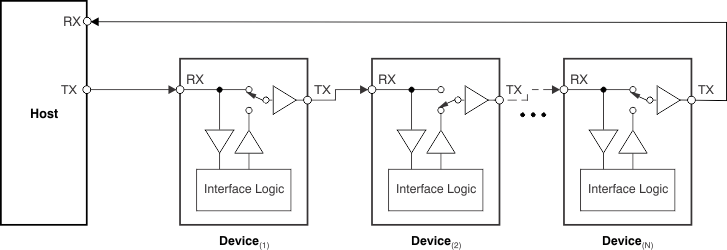SBOS891C October 2018 – September 2023 TMP144
PRODUCTION DATA
- 1
- 1 Features
- 2 Applications
- 3 Description
- 4 Revision History
- 5 Pin Configuration and Functions
- 6 Specifications
- 7 Detailed Description
- 8 Application and Implementation
- 9 Device and Documentation Support
- 10Mechanical, Packaging, and Orderable Information
Package Options
Refer to the PDF data sheet for device specific package drawings
Mechanical Data (Package|Pins)
- YBK|4
- YFF|4
- YMT|4
Thermal pad, mechanical data (Package|Pins)
Orderable Information
7.5.6 Individual Read and Write
The host can initiate an individual read and write command to a particular TMP144 device in the daisy-chain by sending the read/write command. The read/write command consists of these parameters:
- C[7] = 0 (Individual device access)
- C[6:3] = the device ID (ID[3:0])
- C[2:1] = the data register pointer (P[1:0]); see Table 7-3
- C[0] = indicates read/write control
As shown in Figure 7-14, an individual device write command is indicated by C[0] = 0. The host must transfer at least one more byte of data for the register indicated by bits C[2:1]. The TMP144 in the daisy-chain that corresponds to the device ID noted by bits C[6:3] then updates the appropriate register.
 Figure 7-14 Individual Write Command Flow.
Figure 7-14 Individual Write Command Flow. As shown in Figure 7-15, an individual device read command is indicated by C[0] = 1. As shown in Figure 7-16, the TMP144 in the daisy-chain that corresponds to the device ID pointed by bits C[6:3] then breaks the bus, transmits the data from the register pointed by bits C[2:1], and reconnects the bus.
 Figure 7-15 Individual Read Command
Flow.
Figure 7-15 Individual Read Command
Flow.  Figure 7-16 TMP144
Daisy-Chain: Bus Status During Individual Read Operation of Second
Device
Figure 7-16 TMP144
Daisy-Chain: Bus Status During Individual Read Operation of Second
Device